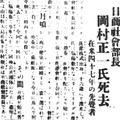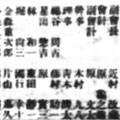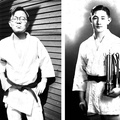In the last chapter, I wrote about the development of the Japanese hotel industry. In this chapter, I will share articles about Japanese newspapers, especially about the North American Times. In the first part of Chapter 10, I review articles that describe the early days of the North American Times.
BIRTH OF JAPANESE NEWSPAPERS
In the early 20th century, as the Japanese community grew in Seattle, various Japanese newspapers appeared. Kiyoshi Kumamoto, a dentist, and Kuranosuke Hiraide, the founder of Hiraide Store (Reference: “Chapter 4—Notable People in Seattle” - Kuranosuke Hiraide), Juji Yadagai, and Ichiro Yamamoto invested together to launch the North American Times. It’s first issue was published on September 1, 1902. The chief editor was Sakutaro Sumigyu Yamada. The office was located inside of the basement of Hiraide Shoten, on Jackson Street.
In the same year, Shin Nippon began. Asahi Shimbun (The Asahi News) also started on March 1, 1905, and Taihoku Nippo” (The Great Northern Daily News) followed on January 1, 1910. The Japanese newspapers were significant information sources for Japanese immigrants who did not read English.
CHIEF EDITORS IN THE EARLY DAYS
Gogai Nakajima, who used to work for Shin Nippon, writes about the North America Times in its founding era.
“The North American Times and Me” (From the Mar. 29, 1918 issue)
“I came to the US in July 1903. At that time, there were two major daily newspapers in Seattle, the North American Times and Shin Nippon. The North American Times represented a group of prospering businessmen. In contrast, Shin Nippon had a sort of ‘revolutionary’ tone. The Japanese community in Seattle was heading toward its golden age, so the power of the North American Times was noticeable.
“The day after I landed, I visited the office of Oriental Trading Company (Toyo Boeki Gaisha) and met Ototaka Yamaoka, the president of Shin Nippon. After listening to his lengthy speech, I joined Shin Nippon.
“Mr. Yamaoka had a few writers including Kawakami as chief editor. At the North American Times, Nashimura Hatsugano was the general chief. Nashimura-sensei, who is now retired and no longer appears at social events, was like a community star back then. All the young writers were following after him.
I must not forget mentioning former president and owner Mr. Kumamoto. His struggle with a strong attachment to the publishing business was remarkable. I believe that today’s North American Times is the result of the efforts of his hard work without sleeping.
The North American Times was against outlandish and radical revolution. Rather, sometimes, the newspaper attacked plans by radical activists. The paper was moderate and opportunistic. The two daily newspapers (North American Times and Shin Nippon) were totally different.... I told the printing craftsman to choose disagreeable words so I can create articles attacking Nashimura-sensei. I selected worse slanders every day. Now, when I enjoy teatime with Mr. Nashimura, we both laugh out loud about these dirty debates we used to have between the two papers.
Eventually I left Shin Nippon and lived in Eastern Washington for a while. When I came back, the North American Times had become a decent respectable newspaper, rather than an immature town paper. What I remember is that the change happened when Tetsuyuki (Shiro) Fujioka was working as chief editor. The sincerity of his tone, and his moderate and honest writing certainly upgraded the paper. I think that the basis of today’s North American Times was formed during the Fujioka era.
When I lived in Pasco nine years ago (in 1909), I sent a letter to Mr. Fujioka and asked him to support the development of Pasco’s Japanese community. He immediately replied yes. I started contributing articles about Pasco to the North American Times. The effect of the newspaper was amazing. Surprisingly, many Japanese visited the desert after seeing my articles. Soon, a Japanese laundry and a general store were opened in Pasco. Some restaurants followed. That made me so busy. The contribution of the newspaper to Pasco’s regional development was substantial.
“I would like to pay tribute to the dedication of the North American Times and its efforts that contributed to the development of the Japanese community.”
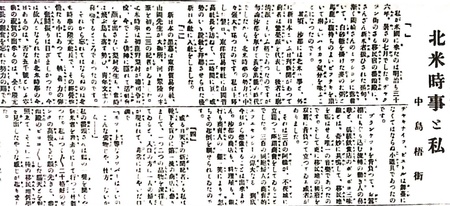
In 1918, the North American Times hosted a memorial ceremony for its founders.
“Headquarters Memorial Ceremony” (From the Jul. 29, 1918 issue)
“The day before yesterday, a memorial service was held at Manshinro Restaurant to commemorate the deceased who were associated with the North American Times, including Kiyoshi Kumamoto and Juji Yadakai. Mr. Sumigyu Yamada gave a memorial speech. It was a great ceremony with many attendees.”
ARIMA FAMILY
In 1913, the ownership of the North American Times was handed over to Sumikiyo Arima from Kumamoto. From then, the Arimas continued publishing the paper until its last issue on March 12, 1942. Sumikiyo’s older son Sumiyoshi Arima worked as president for decades. He was once president of the Nihonjin-kai (Japanese Association) in the 1930s. At the start of World War II in December 1941, he was forced to leave his position, as he was stuck in Kumamoto while visiting his sick father, Sumikiyo. Sumiyoshi’s younger brother Sumio Arima became president, but he was arrested by the FBI on the day of the Pearl Harbor attack. Sumio was one of the original members who continued the paper as The North American Post after the war.
Ryozo Azuma, who worked for the North American Times in the 1910s, described the time when the Arima family started.
“Recollections of Three Decades Ago—Seattle, the North American Times and Me” (From the Jan. 1, 1938 issue)
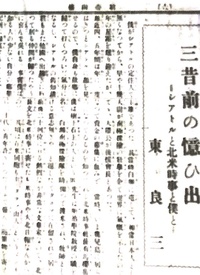 Ryozo Higashi, "Memories from Three Years Ago" - Seattle, North American Current Affairs, and Me - (North American Current Affairs, January 1, 1938 issue)
Ryozo Higashi, "Memories from Three Years Ago" - Seattle, North American Current Affairs, and Me - (North American Current Affairs, January 1, 1938 issue)“I first started working for the North American Times around 1909, when Mr. Kumamoto was president. Mr. Shiro Fujioka, who is now in Los Angeles, was the chief editor. Arima-sensei (Sumikiyo) had just resigned from the position of professor of Meiji Gakuin University and moved to America as a minister of a church in Tacoma. He is a great writer and was contributing his articles to the North American Times and to Taihoku Nippo. His penname was ‘Tacoma Sanjin’ (people in mountain). He became a partner of us literary fellows.
After a while, Arima-sensei took over the North American Times from Mr. Kumamoto and became its president and chief editor....It was around that time (1917) when the current president, Sumiyoshi Arima, started working for the publisher. Sumiyoshi was a young student who had just graduated from a college in Portland. To reveal a secret, the romance between his wife Tamaki (maiden name, Fukuda) began when he was in Portland.”
The next part will introduce articles related to the increased contributors to the North American Times and its employees.
Reference:
Jushiro Kato, Zaibei doho hattenshi (History of Brotherhood in the United States), Hakubunsha, 1908.
Zaibei nihonnjinkai jiseki hozonbu ed., Zaibei nihonjin shi (History of the Japanese in the US), Zaibei Nihonjin kai, 1940.
Sumisato Arima, Shiatoru nikkan hojishi no 100-nen (100 Years of Daily Japanese Newspapers in Seattle), Tsukiji Shokan, 2005.
*The English version of this series is a collaboration between Discover Nikkei and The North American Post, Seattle’s bilingual community newspaper. This article was originally publishd on December 31, 2021 in The North American Post and is modified for Discover Nikkei.
© 2021 Ikuo Shinmasu



